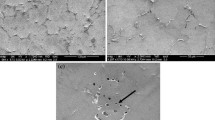Abstract
The tensile data showed that strength and percent elongation of the Zr-containing 354 (Al–9%Si–1.8%Cu–0.5%Mg) alloys increased in the one-step solution heat-treated condition compared to the as-cast case. The multi-step solution heat treatment displayed higher tensile properties than those achieved with single-step solution heat treatment. The use of the T6 treatment, incorporating the multiple solution heat treatment, allows for maximum dissolution of the copper phases in the multiple stages of solution treatment, resulting in the greatest improvement in the alloy strength. The best tensile properties of alloys tested at room temperature after stabilization at 250 °C for 200 h are obtained with the T6 heat treatment. The addition of Zr, Ni, and Mn to Al–Si alloys improves the high-temperature tensile properties of the 354 alloy. Alloys containing 2%Ni or 0.75%Mn perform better in case of high-temperature conditions, with 1-h stabilization at 250 °C. After 200-h stabilization at 250 °C, the strength of the T6-treated alloys—regardless of the type of solution heat treatment process, is reduced considerably, while the ductility is increased, with base alloy showing the highest percent elongation, ~ 19%. The reduction in strength may be attributed to the alloy softening which occurs after such long stabilization time at the high testing temperature (250 °C).












Similar content being viewed by others

References
R. Lemon, C. Howle, Premium strength aluminum casting alloys 354 and 359. Trans. AFS 71, 465 (1963)
J.G. Kaufman, E.L. Rooy, Aluminum Alloy Castings. Properties, Processes and Applications (ASM International, Cleveland, 2004)
J.R. Davis, Aluminum and Aluminum Alloys (ASM International, Cleveland, 1993)
M. Zheyuan, Effect of Fe-Intermetallics and Porosity on Tensile and Impact Properties of Al–Si–Cu and Al-Si-Mg Cast Alloys, Ph.D. dissertation, Université du Québec à Chicoutimi (2002)
F. Samuel, A. Samuel, Effect of heat treatment on the microstructure, tensile properties, and fracture behavior of permanent mold Al-10 Wt Pct Si-0.6 Wt Pct Mg/Sic/10 P composite castings. Metall. Mater. Trans. A 25(10), 2247–2263 (1994)
P. Ouellet, F.H. Samuel, Effect of Mg on the ageing behaviour of Al–Si–Cu 319 type aluminium-casting alloys. J. Mater. Sci. 34, 4671–4697 (1999)
M. Zeren, Effect of copper and silicon content on mechanical properties in Al–Cu–Si–Mg alloys. J. Mater. Process. Technol. 169, 292–298 (2005)
M.I. Ibrahim, A.M. Samuel, H.W. Doty, F.H. Samuel, Response of varying levels of silicon and transition elements on room- and elevated-temperature tensile properties in an Al–Cu alloy. Int. J. Metalcast. 1, 396–414 (2018)
A.M.A. Mohamed, F.H. Samuel, Microstructure, tensile properties and fracture behavior of high temperature Al–Si–Mg–Cu cast alloys. Mater. Sci. Eng. A 577, 64–72 (2013)
J. Hernandez-Sandoval, G.H. Garza-Elizondo, A.M. Samuel, S. Valtiierra, F.H. Samuel, The ambient and high temperature deformation behavior of Al–Si–Cu–Mg alloy with minor Ti, Zr, Ni additions. Mater. Des. 58, 89–101 (2014)
P. Crepeau, Effect of iron in Al–Si casting alloys: a critical review (95–110). Trans. Am. Foundrymen’s Soc. 103, 361–366 (1995)
Z. Asghar, G. Requena, H.P. Degischer, P. Cloetens, Three-dimensional study of Ni aluminides in an AlSi12 alloy by means of light optical and synchrotron microtomography. Acta Mater. 57, 4125–4132 (2009)
L.F. Mondolfo, Manganese in Aluminum Alloys (The Manganese Centre, 191 Ave. Charles de Gaulle, 92521 Neuilly sur Seine, France. 1978 (Pamphlet), 1978)
Z. Asghar, G. Requena, F. Kubel, The role of Ni and Fe aluminides on the elevated temperature strength of an AlSi12 alloy. Mater. Sci. Eng. A 527, 5691–5698 (2010)
M. Drouzy, S. Jacob, M. Richard, Interpretation of tensile results by means of quality index and probable yield strength-application to Al–Si7 Mg foundry alloys-France. Int. Cast Met. J. 5, 43–50 (1980)
M.H. Abdelaziz, H.W. Doty, S. Valtierra, F.H. Samuel, Static versus dynamic thermal exposure of transition elements-containing Al–Si–Cu–Mg cast alloy. Mater. Sci. Eng. A 739, 499–512 (2019)
M.H. Abdelaziz, E.M. Elgallad, H.W. Doty, S. Valtierra, F.H. Samuel, Melting and solidification characteristics of Zr-, Ni-, and Mn-containing 354-type Al–Si–Cu–Mg cast alloys. Philos. Mag. 99(13), 1633–1655 (2019)
M.H. Abdelaziz, A.M. Samuel, H.W. Doty, S. Valtierra, F.H. Samuel, Effect of additives on the microstructure and tensile properties of Al–Si alloys. J. Mater. Res. Technol. 8(2), 2255–2268 (2019)
D. Northwood, X. Sun, G. Byczynski, J.H. Sokolowski, The development of a two-stage solution heat treatment for cast Al-Si-Cu alloys, in IMMA ADCA Conference Proceedings, vol. 4 (1995), pp. 15–19
A.M. Samuel, H.W. Doty, S. Valtierra, F.H. Samuel, Defects related to incipient melting in Al–Si–Cu–Mg alloys. Mater. Des. 52, 947–956 (2013)
Q.G. Wang, Microstructural effects on the tensile and fracture behavior of aluminum casting alloys A356/357. Metall. Mater. Trans. A 34, 2887–2899 (2003)
L. Alyaldin, Effects of Alloying Elements on Room and High Temperature Tensile Properties of Al-Si-Cu-Mg Base Alloys (Mémoire de maîtrise, Université du Québec à Chicoutimi 2017)
C.H. Cáceres, L. Wang, D. Aphelian, M. Makhlouf, Alloy selection for die castings using the quality index. AFS Trans. 107, 239–247 (1999)
O. Reiso, H.G. Øverlie, N. Ryum, Dissolution and melting of secondary Al2Cu phase particles in an Al–Cu alloy. Metall. Trans. A 21, 1689–1695 (1990)
I.J. Polmear, Metallurgy of the Light Metals, 3rd edn. (Arnold Hodder Headline PLC, London, 1995)
H.R. Ammar, C. Moreau, A.M. Samuel, F.H. Samuel, H.W. Doty, Influences of alloying elements, solution treatment time and quenching media on quality indices of 413-type Al–Si casting alloys. Mater. Sci. Eng. A 489, 426–438 (2008)
Acknowledgements
The authors would like to thank Amal Samuel for enhancing the quality of the images used in the present article.
Author information
Authors and Affiliations
Corresponding author
Additional information
Publisher's Note
Springer Nature remains neutral with regard to jurisdictional claims in published maps and institutional affiliations.
Rights and permissions
About this article
Cite this article
Alyaldin, L., Abdelaziz, M.H., Samuel, A.M. et al. Effect of Transition Metals Addition on Tensile Properties of Al–Si–Cu-Based Alloys at 25 °C and 250 °C: Role of Heat Treatment. Inter Metalcast 15, 60–75 (2021). https://doi.org/10.1007/s40962-020-00427-0
Published:
Issue Date:
DOI: https://doi.org/10.1007/s40962-020-00427-0



